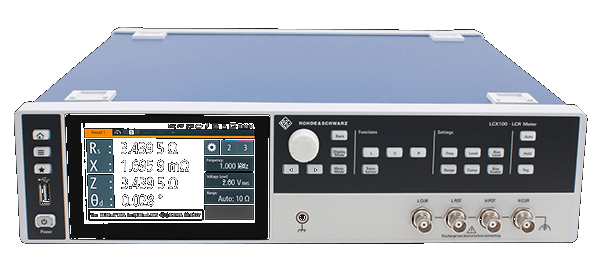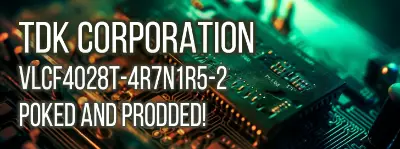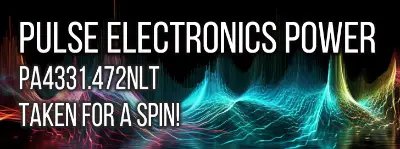Vishay Sprague's 293D476X9025E2TE3 Capacitor Tantalum Molded: In-Depth Performance Analysis
By Mark Harris Friday, 27 January 2023

Introduction
In this review, we will be analyzing the performance of a Capacitor from Vishay Sprague with the part number 293D476X9025E2TE3. This surface-mount capacitor features a nominal value of 47μF, a tolerance of ±10%, and a voltage rating of 25V. The composition is Tantalum: Molded, and the package size is 2917 (7343 Metric). We will be comparing this capacitor's specifications against a statistical benchmark built on the data from similar valued components.
The performance evaluation of the 293D476X9025E2TE3 capacitor will be based on key aspects such as capacitance, series resistance, dissipation factor, and quality factor. For a more comprehensive understanding of how well it performs, we will provide a comparative analysis with the benchmark data.
Key highlights of the review:
- Pros:
- Good quality factor at lower test frequencies
- Low series resistance results at high test frequencies
- Relatively stable series capacitance values across test frequencies
- Higher dissipation factor at high test frequencies when compared to the benchmark data
- Poor quality factor at high test frequencies compared to the benchmark
Stay tuned as we delve deeper into this evaluation, specifically focusing on the capacitance, series resistance, dissipation factor, and quality factor of the 293D476X9025E2TE3 Capacitor by Vishay Sprague.
Impedance
In assessment of the Vishay Sprague 293D476X9025E2TE3 Capacitor's impedance performance, it is essential to analyze how it compares to the established statistical benchmark for impedance measurements. Notably, the component exhibits a mixed performance with respect to the benchmark, demonstrating both higher and occasionally closer impedance values across different test frequencies and voltages.
For example, at 5 Hz and 1 Volt, the benchmark average impedance stands at 656.9 Ohms, while the 293D476X9025E2TE3 Capacitor manifests an impedance of 669.5 Ohms. Moreover, at a higher test frequency of 20 kHz, the component fares slightly worse compared to the benchmark average impedance of 461m Ohms, measuring at 649.6m Ohms. Even at 1 MHz, the Capacitor's impedance of 564.2m Ohms surpasses the benchmark average of 286.2m Ohms.
On the other hand, certain cases show the 293D476X9025E2TE3 Capacitor performing closer to or slightly better than the benchmark. At 100 kHz with a 1 Volt test, the component's impedance is 599.7m Ohms - this lies much closer to the benchmark minimum of 319.4m Ohms, compared to the average of 422.2m Ohms.
Analysis of the 293D476X9025E2TE3 Capacitor at a higher voltage of 10 Volts reveals a similar trend. At test frequencies such as 50 Hz and 500 Hz, the capacitor's impedance values register at 67.17 Ohms and 6.873 Ohms, respectively, which demonstrates only a marginal deviation from the 1 Volt testing values. In conclusion, the Vishay Sprague 293D476X9025E2TE3 Capacitor's impedance performance presents a mixed bag, with values that are at times higher, and on certain occasions, closer or slightly better than the established statistical benchmarks.
Series Resistance
In this performance analysis, the typical series resistance of the 293D476X9025E2TE3 capacitor by Vishay Sprague will be discussed. The capacitor has a nominal capacitance value of 47μF, a tolerance of ±10%, and a voltage rating of 25 volts.
At a voltage of 1 volt, the measured series resistance (also known as equivalent series resistance or ESR) values of the 293D476X9025E2TE3 capacitor range from 9.74 Ohms at a test frequency of 5 Hz to 564.2 mOhms at a frequency of 1 MHz. To have a better understanding of the capacitor's performance, we can compare these results with a statistical benchmark data. The average series resistance values lie below the benchmark levels for frequencies between 50 Hz and 300 kHz. However, for frequencies above 300 kHz, the capacitor's series resistance values are higher than the average benchmark results, with a maximum delta occurring at 1 MHz.
At a voltage of 10 volts, the capacitor's series resistance values range from 283 Ohms at 5 Hz to 562.1 mOhms at 750 kHz. The 293D476X9025E2TE3 capacitor demonstrates better performance at lower test frequencies, as the measured series resistance values are comparatively lower than the statistical benchmark. However, the capacitor's series resistance values are higher than the benchmark data at higher test frequencies (above 300 kHz).
The Vishay Sprague 293D476X9025E2TE3 capacitor exhibits favorable series resistance values at lower frequencies when compared to the statistical benchmark. Series resistance plays a crucial role in capacitor performance because it can lead to energy losses, heat generation, and reduced efficiency in the application. Engineers should consider the capacitor's performance at higher frequencies since the series resistance values tend to be higher than the benchmark data. Application requirements, along with considerations such as temperature stability, ripple current handling, and efficiency concerns, should directly influence the selection of this capacitor for a design.
Dissipation Factor and Quality Factor
At a voltage level of 1V, the 293D476X9025E2TE3 capacitor demonstrates reasonable performance in lower test frequencies such as 5Hz and 10Hz, with dissipation factor (Df) values of 0.014 and 0.013, as well as quality factor (Q) values of 69.52 and 77.23, respectively. It is worth noting that the dissipation factor represents the energy loss within the capacitor, with a lower value indicating a lower level of energy loss. On the other hand, the quality factor represents the efficiency of the capacitor, with higher values indicating more efficient performance.
However, as the test frequency increases, the Df values rise, indicating more energy loss, and the Q values decline, signifying reduced efficiency. For instance, at a test frequency of 100Hz, the Df value is 0.025 and the Q value is 39.46. The capacitor's performance continues to worsen at higher test frequencies such as 10kHz, where the Df value reaches 1.765 and the Q value drops to just 0.57.
In comparison to the benchmark data, the 293D476X9025E2TE3 capacitor exhibits improved Df values and Q values in the mid-frequency range when tested at the 10V voltage level. For instance, at a test frequency of 50Hz, the Df value is 0.041 with a Q value of 24.45, while at a test frequency of 100Hz, the Df value is 0.027 and the Q value is 37.16. Despite these improvements, the Df and Q values still decline significantly as the test frequency increases. For example, a Df value of 9.983 and a Q value of 0.10 are observed at 100kHz, signifying poor performance at high frequencies.
In summary, the 293D476X9025E2TE3 capacitor exhibits acceptable performance at lower test frequencies, but its performance declines substantially at higher frequencies. In order to assess the capacitor's performance relative to the statistical benchmark data more comprehensively, additional comparisons with other capacitors within the same value range are necessary. This will ensure an accurate evaluation and enable users to select a suitable capacitor for their specific applications based on performance requirements and frequency ranges.
Comparative Analysis
The Vishay Sprague 293D476X9025E2TE3 Tantalum Molded Capacitor exhibits varying performance characteristics when compared to the provided statistical benchmark data of components with the same value. It is crucial to note that the data represents the performance of the component at 1 Volt and 10 Volts, while the benchmark data exclusively represents the performance at 1 Volt.
At test frequencies below 50 kHz, the 293D476X9025E2TE3 Capacitor generally exhibits higher impedance values compared to the average impedance values from the benchmark dataset at 1 Volt. Particularly, at 5 kHz and 10 kHz, the capacitor shows impedance values of 669.5 Ohms and 336.5 Ohms, both higher than their respective average benchmark values of 656.9 Ohms and 332.8 Ohms. As the test frequency increases past 50 kHz, the capacitor's impedance values tend to be lower than the average benchmark impedance values.
The dissipation factor of the 293D476X9025E2TE3 Capacitor demonstrates very different behavior in comparison to the benchmark data, with many test frequencies having higher dissolution factor than the average provided by the benchmark. It is important to note, however, that the capacitor's performance demonstrates promising quality factor values compared to the benchmark. For example, at a test frequency of 5 Hz, the capacitor's quality factor value of 69.52 surpasses the average benchmark quality factor value of 28.18.
Furthermore, the series resistance of the 293D476X9025E2TE3 Capacitor at various test frequencies is higher than the benchmark values, especially at lower frequencies which may indicate energy losses in real-world applications. With respect to the series capacitance, the capacitor largely demonstrates similar characteristics to the benchmark data, with the series capacitance values hovering around the nominal value of 47μF.
In summary, engineers exploring whether this Capacitor is an optimal choice should weigh its varying performance characteristics compared to the statistical benchmark values. While its quality factor performs well at certain frequencies, the higher dissipation factor and series resistance values might introduce greater energy losses in real-world applications. A thorough evaluation of the impact of these variables on the intended circuit performance is essential when determining if the Vishay Sprague 293D476X9025E2TE3 Tantalum Molded Capacitor is the right choice for any given application.
Conclusion
Upon analysing Vishay Sprague's 293D476X9025E2TE3 Tantalum Molded capacitor, several key insights can be gleaned when compared to the statistical benchmark data. Overall, the capacitor's performance presents a mixed stance in terms of impedance, dissipation factor, quality factor, series resistance and capacitance. It is important to carefully evaluate its parameters for suitability in a specific engineering design.
At lower test frequencies, the impedance of the capacitor is at the higher range as compared to the average benchmark, while at higher test frequencies, it aligns much closer to the average values. The capacitor performs better in terms of dissipation factor and quality factor at low to medium test frequencies, but not beyond 100 kHz.
Regarding series resistance, the 293D476X9025E2TE3 capacitor showcases a better performance at lower test frequencies, with results close to the benchmark values. However, its series capacitance fluctuates somewhat around the benchmark values across the entire frequency range.
In conclusion, the Vishay Sprague 293D476X9025E2TE3 Tantalum Molded capacitor exhibits a blend of positive attributes and shortcomings, thus engineers must exercise discretion when considering its application in circuit designs. It may be well-suited for designs requiring low dissipation factor and quality factor performance at certain frequency ranges, provided the impedance and capacitance parameters fit the intended use.
Instruments Used
Rohde & Schwarz LCX200



